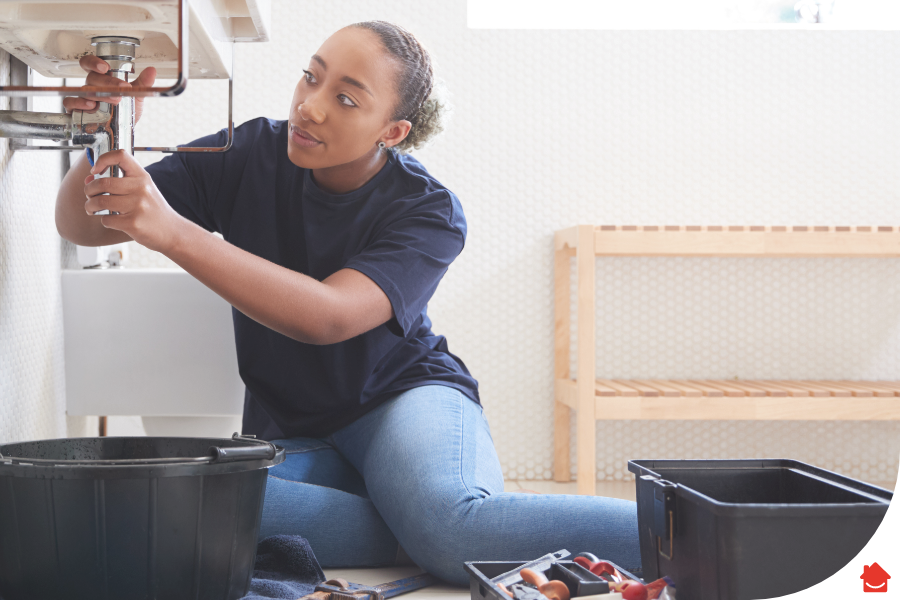Renovating a house is an exciting (and potentially profitable) project, but it can also be pretty daunting.
Yes, you may uncover some beautiful original features previously hidden away, but you may also discover some unavoidable hidden costs of the plumbing variety.
This is because older houses are, well… old. They may have started life with no plumbing or running water at all. (This is the reason many Victorian houses have a bathroom tacked on as an afterthought on the ground floor.)
What’s more, heating was provided via open fires in those days, rather than by modern boilers and radiators. So, any refurbishment you do is likely to involve making significant upgrades to the plumbing and heating systems.
When it comes to plumbing, this guide will help you prepare for what lies ahead with your renovation. This way you can go into your project with your eyes wide open, knowing the potential problems that may arise and having a plan for tackling them so that things stay on schedule and in budget.
Firstly, are you renovating or remodelling?
Renovation actually strictly means restoring a home back to its original state.
Remodelling, on the other hand, means changing it, perhaps through altering its layout or extending.
What most owners of old houses end up doing is a combination of the two – returning original features and the bare bones of the property to their former glory, while playing around with the layout in order to make their home more suitable for modern-day living.
Home renovation basic dos and don’ts
Do create a schedule of works. This is vital to the success of your home renovation project. A good schedule will clearly outline every single job that needs to be carried out, from beginning to end of the project, in the right order. Ideally it should also include who is doing what and how much it will cost. You don’t want any surprises!
Do think about how you’re going to route all the associated pipework for a practical result that minimises physical and visual damage to the character of your house.
Do find out if you need to apply for listed building consent (LBC) for internal works if it’s a listed property. You shouldn’t need specific permission if you’re simply replacing the fittings and/or refurbishing an existing kitchen or bathroom. However, if you’re integrating a new bathroom, increasing the size of either of these rooms or carrying out any structural work, you will need LBC.
Do take care when stripping out any old plumbing installations. Pipework should be drained to avoid pouring large quantities of water (which is likely to be filthy) over sensitive parts of the building.
Do watch out for old pipes – lead pipes, galvanised steel pipes and PB (polybutylene) pipes were all used in the past and are not fit for purpose today – either easily bursting or, in the case of lead piping, extremely toxic. These materials are no longer used, but there are many homes that still contain them. Be careful when removing them.
Don’t install a new bathroom directly above a space that features fine plaster ceilings or painted decoration
Don’t choose a room with important original detailing (such as an original fireplace, panelling or intricate plasterwork) if you’re retrofitting a wet zone – unless you’re sure these can be kept undisturbed by the works.
Don’t remove excess material from plumbing installation that’s left over, especially if it’s not visible, as you could end up damaging the fabric around it, it is better to leave it in place.
Don’t cut into beams or joists if possible; if you must, drill holes through the centre, don’t notch the tops of the wood as this will significantly weaken it.
Fitting pipework
Trying to find routes around your house for plumbing services can be tricky, because there often aren’t any easy answers in old houses that didn’t originally have plumbing.
The main issue is fitting the supply and waste pipes, but it’s important to note that a lot of modern plumbing equipment requires electrical wiring as well, so it’s usually best if plumbing and wiring happen at the same time.
Renewing the pipework often means completely removing the existing system and replacing it with new runs beneath floorboards and within walls.
Think carefully about where the pipes will run to be sure they won’t damage important features or structural elements, such as plasterwork, beams or details in adjoining rooms.
You should also look to make new services easy to reach and remove, as plumbing and wiring have to be regularly maintained. If you’re dealing with pipes that run under timber floors, take care when lifting the boards.
How to get rid of damp when renovating a house
Damp is pretty inevitable if your property is more than 80 years old. This means it’s likely to have solid walls (as opposed to modern cavity walls) and such buildings often suffer from damp problems. Very often the damp will have been caused by inappropriate modern alterations such as:
- replacing lime with cement in pointing or render
- painting using modern impermeable products
- replacing suspended timber floors with concrete
- reducing or covering up vents
- changing external ground levels against the building
What are the most common types of damp?
The two most common types of damp are rising damp and penetrating damp. If you suspect you have damp problems, get an expert opinion on what type of damp you are dealing with in your house renovation – they will need to be treated differently.
Rising damp solutions include:
- improving ground drainage around the property
- lowering the external ground level
- improving ventilation
- even just getting the heating back on
Penetrating damp:
Problems in walls and ceilings can usually be resolved by repairing the building’s fabric, such as:
- repointing brickwork with lime mortar
- repairing lime render or missing hung tiles
- fixing the roof
- repairing lead flashings and valleys, guttering and doors and windows
How to treat rot and woodworm
When you’re treating damp, be sure to treat any signs of infestation, such as rot and woodworm. Conservationists often frown upon spraying chemicals in buildings to treat rot and woodworm, as these problems should resolve themselves in a few months once your damp problems are fixed and the house is heated. However, not everyone is willing to wait or take any risks and lenders often insist on chemical treatments as a condition of their loan.
Does your home renovation project need new drains?
To find out whether the existing drains are in working order, find the inspection chambers (manholes) and pour different colour food dye down the loos and sinks to find out which is connected to which, and whether any drains have collapsed and need digging up.
You’ll need to wait until any scaffolding is down to connect the external drains to the sewer or septic tank. Some renovators prefer to undertake this work at the groundworks stage, but this leaves the drains vulnerable to damage during building work, especially if they’re exposed in the trenches around the building before backfilling.
If you’re building an extension you may need to relocate drains anyway, so now is the time to find out. If there is no mains drainage, inspect the condition of the existing septic tank and soakaways.
How much is a new plumbing system?
We’re not going to beat around the bush. It’s expensive to rewire and replumb a house, but both projects offer you the chance to install systems specifically tailored to your lifestyle, how much energy you use and any future plans you have for your home or family. Updating heating and electrics will also add significant value to the property if you should choose to sell in the future.
You may find that the heating and electrics have been updated to a good standard quite recently, in which case you might just need new radiators. If the radiators are old it’s likely that they’ve got a build-up of sludge inside. Having them power flushed can make a huge difference – read our article on How to power flush your radiators.
Of course, because it’s a renovation project and anything goes, you may want to forget radiators altogether in favour of underfloor heating!
Health and safety tips
Because we’re talking about water and heating, we’re also talking about posing a considerable risk to both the property and its occupants if the work you do isn’t properly managed and completed.
5 things to consider when renovating or replumbing
- Make sure you know the location of the main stop tap. Turn it on and off at least once a year to ensure it works.
- Central heating gas boilers and other appliances powered by this fuel may only be installed and serviced by engineers on the Gas Safe Register and carbon monoxide alarms should always be fitted.
- Asbestos was often used around pipes and heating installations in the mid to late 20th century. If you suspect Asbestos is present, get specialist help to have it properly removed and disposed of.
- To avoid fire risks, stop any hot works at least an hour before leaving the site and make sure the area is thoroughly checked before locking up.
- Check your existing water heater. If it’s incorrectly installed it’s a serious concern, as it could burst and overflow in the house. It may even be leaking carbon dioxide. Common installation errors include no Temperature Pressure Relief (TPR) valve drain pipe, no catch pan, unprotected electrical cables and inaccessible circuit breakers. Get a professional to check that it’s safe and working properly.
Talk to us about renovation cover
If you’re considering a renovation, get in touch about plumbing and drainage cover. If you’re in the middle of a renovation and need help, speak to our repairs team and we’ll be on our way.
FAQs
What are the most common plumbing problems when renovating?
-
- Old pipes – lead pipes, galvanised steel pipes and PB (polybutylene) pipes were all used in the past but aren’t fit for purpose today – either easily bursting or corroding or, in the case of lead piping, extremely toxic. These materials are no longer used, but there are many homes that still contain them. Be careful when removing them.
- Asbestos – it was often used around pipes and heating installations in the mid to late 20th century. If you suspect Asbestos is present, get specialist help to have it properly removed and disposed of.
- Damp – It’s pretty inevitable if your property is more than 80 years old. The most common two types are rising damp and penetrating damp. Rising damp solutions include: improving ground drainage around the property, lowering the external ground level, improving ventilation and even just getting the heating back on. Penetrating damp problems in walls and ceilings can usually be resolved by repairing the building’s fabric.
- Fitting pipework – Trying to find routes around your house for plumbing services can be tricky in old houses that didn’t originally have plumbing. The main issue is fitting the supply and waste pipes. It’s usually best if plumbing and wiring happen at the same time.
- Drains – They may not be in working order. To find out, find the inspection chambers (manholes) and pour different colour food dye down the loos and sinks to find out which is connected to which, and whether any drains have collapsed and need digging up. You may also need to connect up the external drains to the sewer or septic tank.




